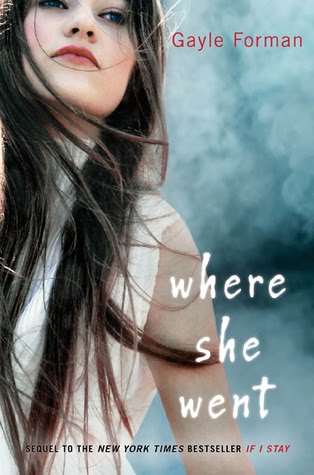
Book Review: Where She Went by Gayle Forman
Written by: Beth Woodward, CC2K Books Editor
 Two years ago, I named Gayle Forman’s young adult novel, If I Stay, as one of the best books of 2009. It follows a 17-year-old girl, Mia, in the 24 hours after her parents are killed and she is left hovering between life and death in a coma after a car accident.
Two years ago, I named Gayle Forman’s young adult novel, If I Stay, as one of the best books of 2009. It follows a 17-year-old girl, Mia, in the 24 hours after her parents are killed and she is left hovering between life and death in a coma after a car accident.
Where She Went picks up three years after the first novel. Told from the perspective of Mia’s once-boyfriend, Adam, it shows what happened to both characters in the three years since Mia’s accident. In its own way, Where She Went is just as harrowing as the first book, and just as beautiful.
The description, courtesy of the Penguin Books website:
It’s been three years since the devastating accident . . . three years since Mia walked out of Adam’s life forever.
Now living on opposite coasts, Mia is Juilliard’s rising star and Adam is LA tabloid fodder, thanks to his new rock star status and celebrity girlfriend. When Adam gets stuck in New York by himself, chance brings the couple together again, for one last night. As they explore the city that has become Mia’s home, Adam and Mia revisit the past and open their hearts to the future-and each other.
Told from Adam’s point of view in the spare, lyrical prose that defined If I Stay, Where She Went explores the devastation of grief, the promise of new hope, and the flame of rekindled romance.
If I Stay was—and remains, to this day—one of the saddest, most touching books I’ve ever read. But as much as I loved it, it felt curiously unfinished. Deciding whether to live is one thing; actually doing it is another. It seemed like Mia and Adam’s story had only just begun.
Where She Went is, in its own way, just as harrowing as the first book, and much darker. After being left behind by Mia without even a goodbye, Adam is in a dark place. He writes several songs to help him deal with his grief and anger—songs that end up as Collateral Damage, the album that shoots his band to superstardom. But as a result of Adam’s increasing isolation and newfound media glory, he has become estranged from his bandmates. His girlfriend is a famous actress, but the feelings he has for her never come close to what he felt for Mia. He smokes, he pops anti-anxiety meds like they’re candy, and he’s developed a tremor. He’s not quite a rock star cliché, but he’s definitely in a bad way.
While on a tour stop in New York, Adam attends a concert that Mia, an up-and-coming cellist, is playing at Carnegie Hall. When Mia discovers Adam is in the audience, she invites him to meet her backstage afterward. From there, they spent an intense night wandering the streets of New York City, alternately avoiding and confronting the ghosts of their shared past. (With the wandering, the constrained time frame, and the push-and-pull dynamic of their relationship, it reminds me a bit of Before Sunrise and Before Sunset. I wonder if Forman had those in mind as inspiration.)
Where She Went’s best scenes are the ones Mia and Adam share. There’s always such an undercurrent of emotion between them, even in their happier moments. We get to see, for the first time, Mia through Adam’s eyes, and the sense of betrayal he feels because she left him. But we also get to see how Mia has coped with the fallout of the last three years, the loss of her family and life as she knew it. But Adam has lost as well, and grieved. Mia and Adam never felt like a high school relationship to me, and their connection in the first book is so palatable that the devastation Adam feels at losing Mia makes a lot of sense, as does Mia’s need to distance herself from him.
Where She Went shows how love can build you up, and how it can destroy you. Forman navigates us through these murky, difficult waters with a skill few writers match. Although it was a hard book to read, it was worth it in the end, and I’m glad Forman brought Mia and Adam’s story to a more satisfying conclusion.
Where She Went is available for sale from Dutton Juvenille now.
